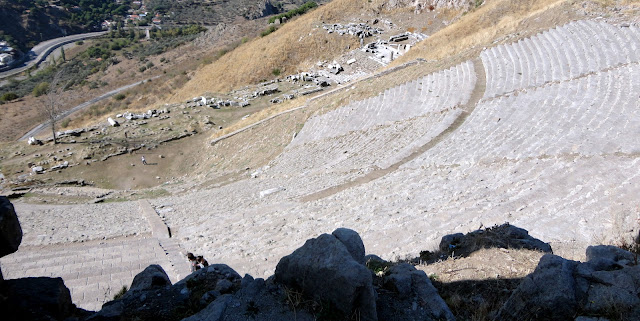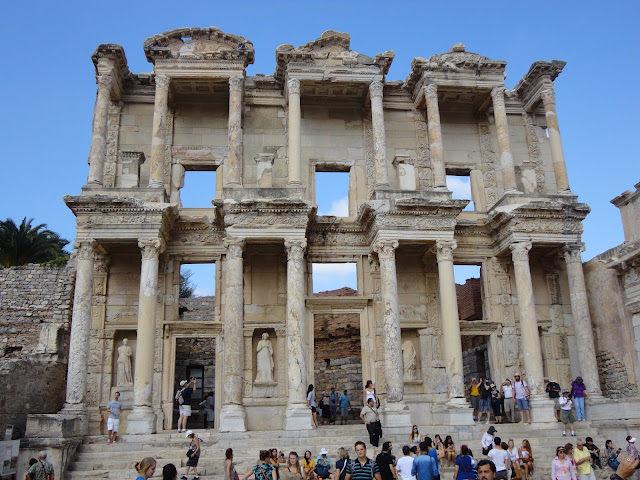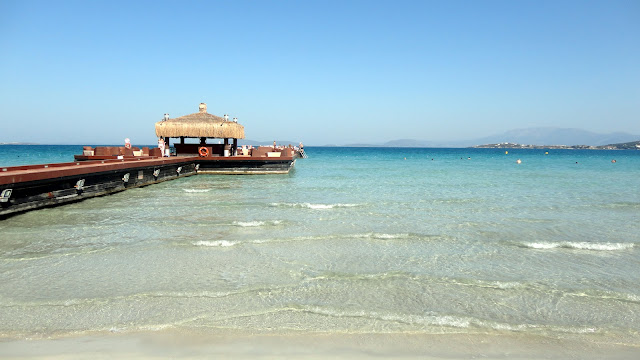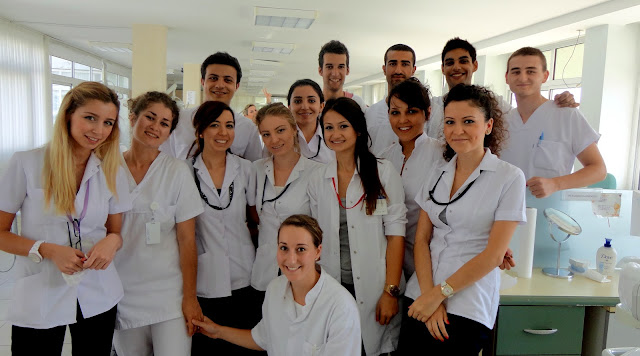After a few weeks without travelling much, we decided to go to Bergama during the Turkish holiday of Bayram since there are no classes whatsoever. I really felt the need to do a bit of traveling, being in the same place weeks for a row without meeting new places can be really boring when you are on Erasmus! Our last big trip was to Pamukkale and that seemed ages ago.
I did a bit of searching and found out a really nice place near Izmir: Bergama, also called Pergamon in the ancient times.
So we caught the dolmuş to Izmir's bus terminal, and then we went to Bergama in a small Metro bus. The price is quite reasonable - 10 TL (less than 5 €uros) por a hour and a half trip. After the small travel, we arrived to the center of a modest city that once was the capital of an entire kingdom.
 |
| The center of Bergama |
Bergama is relatively small for a person that is used to Izmir, although it doesn't have tall buildings its quite spread out, ranging 7 km from beginning to end - but its size can't compare to its historical value. The Metro bus left us in the center of the town, at a walking distance to the Archaeological Museum and the Asklepion, but there are some companies that leave the passengers at the entrance of the town - you'll need to catch a Taxi or hitchhike to get to the touristic places.
Pergamon was an important kingdom during the second century BC, having grown from a city-state captured by Alexander the Great. Later it became the capital of the Pergamon Empire, rulled by the Attalid dynasty. The city was beautified by the building of the 'Altar of Zeus', by constructing numerous buildings in the "middle city" on the slope of the Acropolis, and by expanding and beautifying the Asclepion medical center. When Pergamum's power declined, the Kingdom of Pergamum was willed to Rome and became its Province of Asia Minor.
Roman Pergamum was still a rich, important city. Some of its most important monuments, such as the Temple of Trajan, date from Roman times.
To see in Pergamon
For a one-day trip such as mine, you can see at least 4 main points of Pergamon - the Asclepion, the Acropolis, the Red Basilica and the Museum.
 |
| The Acropolis as seen from the Asclepion |
The Asclepion was the world's most famous ancient medical center, and is the second-most important site in Bergama. It's located west of the city center, 1.6 km north of the main street, 6 km of the Otogar and 1 km west of the city center.
To get there, we first walked from the city inner bus terminal to the main square (where there is a cool statue of Galen as you can see in the picture above) and went up the road, passing through a large Turkish army base. At the entrance of the Asclepion you'll find a very dodgy and bad smelling neighborhood. We didn't have any problems whatsoever, but be carefull.
The entrance fee is 15 TL (unless you have a Museum Card like me and then it's free =D). Once you enter, you'll walk along a monumental marble street bordered by columns - the Via Teta. This was once an active market street, with shops lining both sides of the street.
 |
| The center square |
The Asclepion of Pergamum became famous under Galen (131-210 AD), a local physician who pursued his medical studies in Greece and Alexandria (Egypt) before settling here as doctor to Pergamum's gladiators. This was not your average medical clinic, but a complete health spa with state-of-the-art (for the day) treatment methods. Patients exercised or took the honey cure. They could walk among the trees and be calmed by the scent of pine. Their dreams were analyzed for diagnostic purposes, their diets were closely supervised, they were given mud baths and massages, they were treated with herbal medicines, they had access to a library and a 3,500-seat theater to help them relax and deal with stress, and they drank from a sacred spring (below Diogo drinking of it) and bathed in its waters.
 |
| Diogo drinking of the sacred spring |
Coming into the main precinct of the Asclepion, notice the large marble column fragment bearing the Asclepion's symbol: two snakes facing each other across a wheel. As snakes shed their skins are are "reborn," so patients at the Asclepion were to shed their illnesses and regain health.
You'll have some nice things to see, such as the theater and lots of well preserved Greek columns.
 |
| Asclepion's theater |
Once we finish out visit, we decided to go to the Acropolis. The question was: how? It's a 5,5 km walk until there. Since we are Erasmus and we should try to experiment new things, we went by the side of the road and hitchhiked. Almost immediately two guys in a old car stopped and took us to the cable car that goes to the Acropolis. Of course none of them spoke English and the doors hadn't any doorknobs, but even so we arrived safely!
To get to the Acropolis you have 2 options - walk the entire hill or take the cable car for 5 TL (one way) or 10 TL (round trip). We decided to go on the cable car, and go walking in the return trip. Once you arrive on the top of the hill you'll see lots of people selling the usual touristic stuff. I made a good deal buying 12 postcards for 1,5 TL. To enter the Acropolis you pay 20 TL (again, free with the museum card). There you have lots of places to see, the area is quite big and full of ruins.
 |
| Proposed reconstruction of the Acropolis |
 |
| Fantastic view of Bergama from the Acropolis |
The most prominent building here is the Traianeum, or Temple of Trajan, a huge marble temple that has been partially reconstructed from ruins found on the site. Beside it is the Temple of Athena, also partially reconstructed. Between the Traianeum and Athena temple was Pergamum's famous library of 200,000 volumes, who were offered to Cleopatra by Marc Anthony as a wedding present. In a note, the Portuguese word "pergaminho" (meaning parchment in English) may had it's origin here.
Behind these to the east are the ruins of numerous dark stone palaces but not much to look at, you'll basically see broken columns. My favorite spot, carved into the steep hillside, was the dramatic Hellenistic theater. Like most Hellenic and Hellenistic theaters, it offered a scenic panorama just in case the play was boring, and quite a view it was! We stopped there to have a nice lunch, bread with Nutella. On the base of the theater there are some more ruins, from the Dyonisus temple - I don't know why but I really liked that place in particular and felt really good when I went down there. But keep in mind that you'll have to go up across the theater again, with a few hundred of steps... truly breath taking!
 |
| The Dramatic Theater |
 |
| As seen from the base up |
Just down the hill from the summit was the site of the Altar of Zeus, now in Berlin. After visiting the place it was time to go down the hill walking. Buuuut... since no one was checking the tickets we just caught the cable car again for free!
After the Acropolis we went down the street and visited the Kızıl Avlu - the Red Basilica. This place was built was built for worship of the Egyptian gods Serapis, Isis and Harpocrates at a time in the 2nd century AD when Egyptian religion was reaching into the Roman Empire (I was surprised by this, didn't know that the Egyptian religion had left Egypt and reached this place so far away!). It was later converted into a church dedicated to St. John.
 |
| The Red Basilica viewed from the street |
 |
| Closer look of the main building |
Our last place to see was the Bergama Museum- but again, it was a long way to go by walking. So we hitchhiked again! At our first attempt a turkish man appeard and took us to the entrance of the museum! We decided to visit this towards the end because it's close to the main road and the other sites were our priority.
The museum has a front garden dotted with sculpture, and clean and tidy interior galleries holding artifacts from the excavations of Acropolis and Asclepion. It's quite small so you can see it in less than an hour. You can see the model of the stupendous Altar of Zeus from the acropolis, the original of which is now in Berlin and marble sculpture and statues in the museum are of the Pergamon's school, which followed that of Aphrodisias.
After this, we tried to hitchhike back to Izmir (which is about 150 km). After several frustrated attempts, a group of three Turkish man gave us a ride. We thought we were heading back to Izmir, but they just left us at a gas station on the entrance of the highway to Izmir. We again tried several times to get a ride, but after several honks and laughs from the drivers, we just went to the bus terminal at the entrance of the city and got home safely and comfortably... for less than 5 €uros!
Credits to Turkey Travel Planner and Welcome To Hosanna for parts of the text.
























